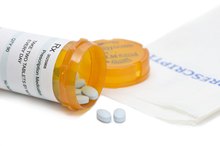Long-Term Effects of Taking Oxycodone
Oxycodone is a schedule II narcotic analgesic. Schedule II drugs have a high risk of abuse but are also considered safe for accepted medical treatment protocols. An analgesic is a type of medication used to control pain. Oxycodone is marketed either alone or in combination with other medications, such as aspirin, to control moderate to severe pain. Oxycodone pain reliever is available in pill form in a variety of combinations, and any product that contains oxycodone is a schedule II narcotic.
If you are experiencing serious medical symptoms, seek emergency treatment immediately.
Considerations
Living drug free may not be possible if you experience pain daily. Work with your physician to create a treatment protocol that controls your pain. If a derivative of oxycodone is included in the treatment recommendations there are several factors that should be considered. Oxycodone acts like an opiod drug. In high doses it causes sedation and poor oxygen exchange. Oxycodone should not be prescribed to women who are pregnant or anyone who has a history of addiction to prescription or street drugs. If you are elderly, have liver or kidney damage, or are currently on another opiod-type drug, the amount prescribed will vary to accommodate your particular needs. People who have or are suspected to have a paralytic ileus or who have acute or severe asthma should not take oxycodone.
- Living drug free may not be possible if you experience pain daily.
- If a derivative of oxycodone is included in the treatment recommendations there are several factors that should be considered.
Side Effects
Side Effects of Fastin Diet Pills
Learn More
The side effects of oxycodone are related to the organs that are affected by the drug, such as the liver, brain and kidneys. Some of the more-common side effects include:
- nausea
- constipation
- vomiting
- headache
- itchy skin
- insomnia
- dizziness
Side effects that are not common can include
- allergic reaction
- chills
- fever
- migraine headaches
- palpitation
- anemia
- gout
- arthritis or bone pain
- edema
- agitation
- anxiety
- confusion
- dry mouth
- personality disorder
- heart failure or gingivitis
Long-Term Effects of Oxycodone
One of the long-term effects of oxycodone is addiction that is characterized by greater dependence on the drug and tolerance to the dosage. Tolerance to a drug means that you must take more and more of the medication to get the same early effect.
After long-term use of oxycodone, men may also experience a decreased level of testosterone or enlargement of the prostate. Other long-term effects include excessive sweating, swelling in the arms and legs, and chronic constipation.
Because chronic use leads to tolerance and dependence, you may experience withdrawal symptoms if a prescription is reduced or stopped 1. These withdrawal symptoms can involve signs of central nervous system hyperactivity and will peak 48 to 72 hours after your last dose. Physical symptoms will be eliminated within a week but it may take longer to erase the psychological addiction.
Withdrawal from oxycodone will begin with anxiety followed by an increased rate of breathing, runny nose, stomach cramps, tearing and sweating. Although withdrawal from oxycodone is distressing it is not fatal.
- One of the long-term effects of oxycodone is addiction that is characterized by greater dependence on the drug and tolerance to the dosage.
- After long-term use of oxycodone, men may also experience a decreased level of testosterone or enlargement of the prostate.
Related Articles
References
- Prescription Drug Rehab: What is Oxycontin?
- Texas State Board of Pharmacy Controlled Drugs: What is a Scheduled Drug?
- Elliott JA, Smith HS. Handbook of Acute Pain Management. CRC Press; 2016.
- Purdue Pharma L.P. OxyContin (Oxycodone HCl Controlled-Release) Tablets [package insert]. Revised 2009.
- U. S. Food & Drug Administration. Drugs of Abuse Home Use Test. Updated September 27, 2018.
- Food and Drug Administration. Highlights of prescribing information: Xtampza ER. 2016.
- Food and Drug Administration. Package insert OxyconUtin (oxycodone HCI controlled-release) tablets. Updated September 7, 2007.
- Ordóñez gallego A, González barón M, Espinosa arranz E. Oxycodone: A pharmacological and clinical review. Clin Transl Oncol. 2007;9(5):298-307. doi:10.1007/s12094-007-0057-9
- Webster LR, Webster RM. Predicting aberrant behaviors in opioid-treated patients: Preliminary validation of the Opioid Risk Tool. Pain Med. 2005;6(6):432-42. doi:10.1111/j.1526-4637.2005.00072.x
- American Association for Clinical Chemistry. Drug abuse testing. Updated November 20, 2019.
- Blenheim Pharmacal, Inc. Oxycontin oxycodone hydrochloride tablet, film coated, extended release. Updated January 2010.
- National Institute on Drug Abuse. What are prescription opioids?. Updated June 2019.
- U.S. Food and Drug Administration. Drugs of abuse home use test. Updated September 27, 2018.
Writer Bio
Gail Morris has been writing extensively since 1997. She completed a master's degree in nursing at Indiana University-Purdue University Indianapolis and practiced in medicine for more than 20 years. Morris has published medical articles in peer-reviewed journals and now writes for various online publications and freelances for Internet marketers.









